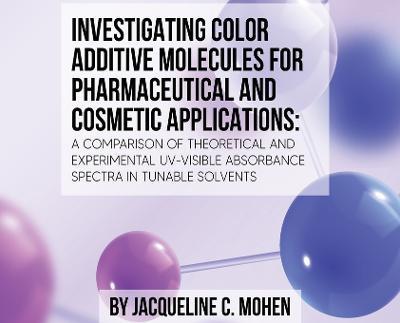Investigating Color Additive Molecules for Pharmaceutical and Cosmetic Applications

Investigating Color Additive Molecules for Pharmaceutical and Cosmetic Applications
As computational developments have changed the way we live by leaps and bounds, it is no surprise that our ability to study sensory-stimulating molecules has also profoundly advanced. In the advent of the vast array of academic journal articles that now exist on the subject, the capability of increased parallelization of processing power, and widespread interest in advanced ab initio quantum computing technologies in our current era, computational study of color additive molecules immersed in solvent or studied in vapor phase has never been easier, and now produces more valuable data regarding UV-visible light maximum absorbance spectral peak responsivity (λmax) than ever before. The studies herein prove that density functional theory (DFT) and time-dependent density functional theory (TD-DFT) serve as effective predictive modelling techniques for generating theoretical λmax for a single color additive molecular structure in a virtual workspace, as well as for modelling multiple structures such as heterodimeric- or a heterotrimeric color additive mixture(s) represented in vapor phase, conventional formulation solvents, and in novel "green" solvent mixtures. In addition, DFT and TD-DFT can also be used to analyze changes in hue attributed to structural anomalies in molecules due to tautomerism, vibronic effects, intra- or intermolecular interactions, implicit or explicit solvation effects, or charge transfer effects on the structure represented in a given solvent or in vapor phase. With ample experimental hue data and corresponding theoretical data presented with full-color images, the modern formulator will revel in the possibilities of using quantum chemical computing methods for perfecting batch hue or to assist in designing novel dye, pigment, and other color additive molecules for use in many different solvents to meet emerging demands
PRP: 500.55 Lei
Acesta este Pretul Recomandat de Producator. Pretul de vanzare al produsului este afisat mai jos.
450.50Lei
450.50Lei
500.55 LeiLivrare in 2-4 saptamani
Descrierea produsului
As computational developments have changed the way we live by leaps and bounds, it is no surprise that our ability to study sensory-stimulating molecules has also profoundly advanced. In the advent of the vast array of academic journal articles that now exist on the subject, the capability of increased parallelization of processing power, and widespread interest in advanced ab initio quantum computing technologies in our current era, computational study of color additive molecules immersed in solvent or studied in vapor phase has never been easier, and now produces more valuable data regarding UV-visible light maximum absorbance spectral peak responsivity (λmax) than ever before. The studies herein prove that density functional theory (DFT) and time-dependent density functional theory (TD-DFT) serve as effective predictive modelling techniques for generating theoretical λmax for a single color additive molecular structure in a virtual workspace, as well as for modelling multiple structures such as heterodimeric- or a heterotrimeric color additive mixture(s) represented in vapor phase, conventional formulation solvents, and in novel "green" solvent mixtures. In addition, DFT and TD-DFT can also be used to analyze changes in hue attributed to structural anomalies in molecules due to tautomerism, vibronic effects, intra- or intermolecular interactions, implicit or explicit solvation effects, or charge transfer effects on the structure represented in a given solvent or in vapor phase. With ample experimental hue data and corresponding theoretical data presented with full-color images, the modern formulator will revel in the possibilities of using quantum chemical computing methods for perfecting batch hue or to assist in designing novel dye, pigment, and other color additive molecules for use in many different solvents to meet emerging demands
Detaliile produsului








